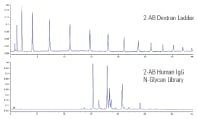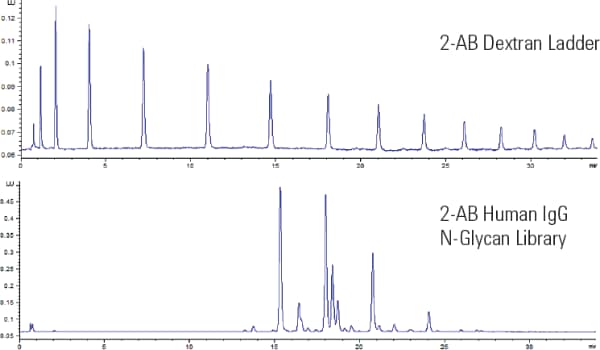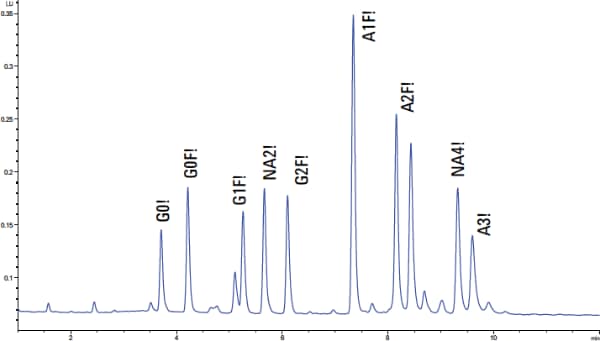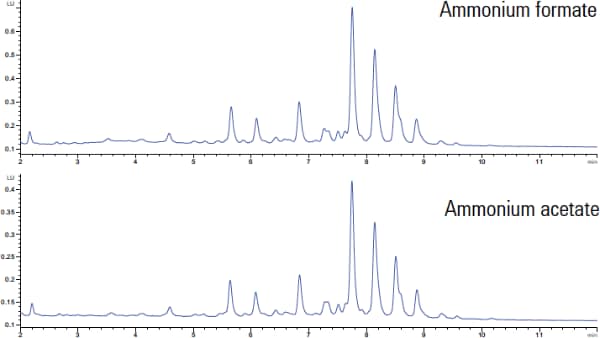Access Agilent eNewsletter November 2015
>> Update My Profile | Subscribe to Access Agilent | Article Directory

Ask the Expert: What’s the best system for characterizing glycans?
By Linda Lloyd
Agilent Product Manager, Biocolumns
Agilent is pleased to introduce a new, informative series of articles from our subject matter experts that provide answers and helpful recommendations for achieving an optimum LC system configuration when characterizing biomolecules. We also offer guidance on a generic method to get you started, and how this method can be further optimized to meet your specific separation goals. In this first article, our experts focus on glycan analysis, using an Agilent 1260 Infinity Bio-Inert LC with AdvanceBio Glycan Mapping columns.
Q: I want high resolution and lower backpressure, so which column should I use?
Answer: AdvanceBio Glycan Mapping columns with 2.7 µm superficially porous particles fit the bill for these applications. Suggested mobile phases are 100 mM ammonium formate, pH 4.5, for eluent A and acetonitrile (MS compatible) for eluent B. A flow rate of 0.5 mL/min delivers high-resolution separations. For high-speed separations, a flow rate up to 1.0 mL/min can be used. However, high aqueous cleanup should ALWAYS be run at reduced flow rate. Table 1 and Table 2 show the suggested gradient for high resolution and for high speed, respectively.
Time (min) |
Eluent A (%) |
|---|---|
|
0 |
25 |
|
32 |
45 |
|
33 |
80 |
|
35 |
80 |
|
36 |
25 |
|
45 |
25 |
Table 1. Suggested gradient for resolution, using a 0.5 mL/min flow rate.
Time (min) |
Eluent A (%) |
Flow rate (mL/min) |
|---|---|---|
|
0 |
25 |
0.7 |
|
12 |
40 |
0.7 |
|
12.5 |
80 |
0.5 |
|
13.5 |
80 |
0.5 |
|
16 |
25 |
0.5 |
|
17 |
25 |
0.7 |
|
20 |
25 |
0.7 |
Table 2. Suggested gradient for speed.
 Enlarge
Enlarge
Figure 1. High-resolution separation of Agilent 2-AB labelled dextran ladder and 2-AB labelled human IgG N-glycan library.
 Enlarge
Enlarge
Figure 2. High-speed separation of 2-AB labeled N-glycans on an Agilent AdvanceBio Glycan Mapping column with 1.8 µm particles with tentative peak assignment.
 Enlarge
Enlarge
Figure 3. Bovine fetuin glycans eluted with ammonium formate or ammonium acetate mobile phases using an Agilent AdvanceBio Glycan Mapping, 1.8 µm column.
For maximum resolution, we use a 1 to 2 µL injection. Samples should first be dissolved in water then made up to 70:30 ACN:water. We also recommend the use of a chiller to vary the temperature of the column compartment. For example, 40 °C gives longer column life – while 60 °C gives sharper peaks but does compromise column lifetime. Selectivity and resolution may change with temperature. In this analysis, an Agilent 1260 Infinity fluorescence detector is used with excitation at 260 nm, emission at 430 nm, and an 8 µL cell. Figure 1 shows an example of a high-resolution separation.
Further details of this analysis are freely available in Agilent publication 5991-6110EN.
Q: What column do I use for fast separation with highest resolution?
Answer: In this case go for the AdvanceBio Glycan Mapping column with 1.8 µm particles, in an Agilent 1290 Infinity II system. The mobile phase, temperature considerations, injection, and flow rates are the same as for high-resolution separations. The small column dimension, 2.1 x 150 mm, still requires small injection volumes. The same fluorescence detector and parameters. The recommended starting gradients are also the same as for the 2.7 µm column. However, although both gradients provide a 1.25%/mL slope, you may need to adjust the start and end point to obtain highest resolution for samples containing different types of glycan. For example, larger glycan structures may require a 75 to 55% acetonitrile gradient for optimum results.
Figure 2 shows a high-speed separation of 2-AB labeled N-glycans.
Q: What is the best mobile phase to use for glycan analysis?
Answer: In glycan analysis, it is important to control the pH and so a buffer is always used. This does limit the options for MS compatibility to formate or acetate for the pH required. Glycans, such as those found in bovine fetuin, can be eluted with either ammonium formate or ammonium acetate mobile phases, as shown in Figure 3.
Full details of this analysis are also freely available in Agilent publication 5991-6183EN.
In next month’s article, we’ll look at size exclusion columns for biomolecule analysis. Our experts will provide answers to common questions on this topic and offer practical suggestions for your own lab work. In the meantime, explore the family of Agilent biocolumns for even more applications.
Advanced Agilent solutions for biopharma
Agilent offers high-resolution columns, sample preparation, and labeled and unlabeled standards to provide the insights you need into your biosimilars. These advanced methods help you correctly determine molecular weight and identity, and find difficult to resolve impurities. See how Agilent biopharma solutions can help advance your biopharma research.
>> Update My Profile | Subscribe to Access Agilent | Article Directory


